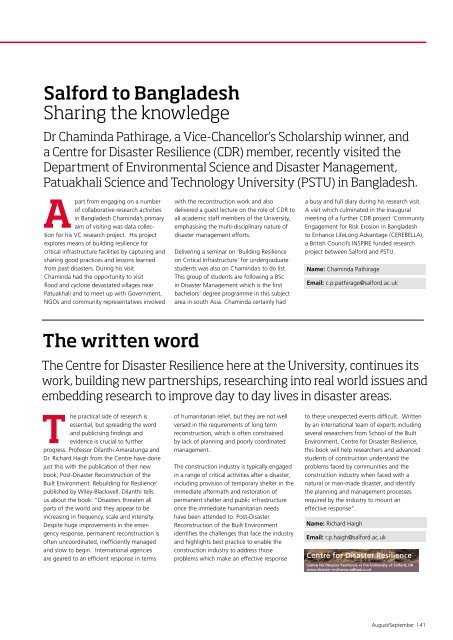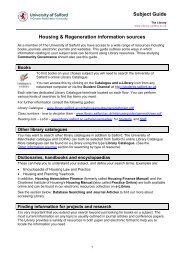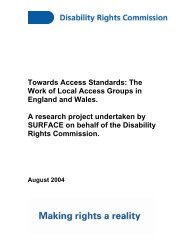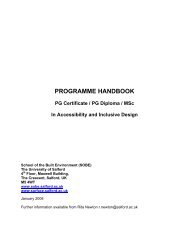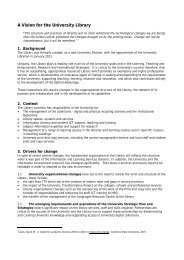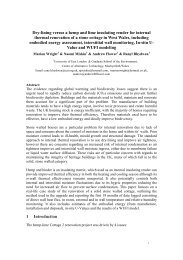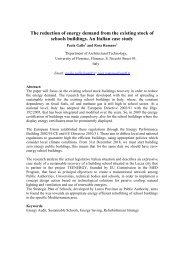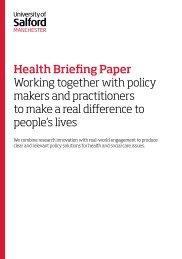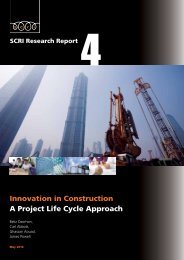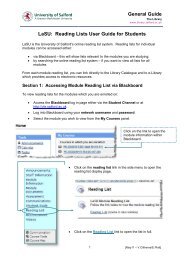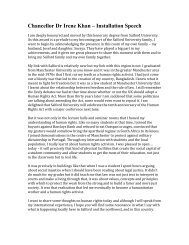RISE August-September 2011 - University of Salford
RISE August-September 2011 - University of Salford
RISE August-September 2011 - University of Salford
You also want an ePaper? Increase the reach of your titles
YUMPU automatically turns print PDFs into web optimized ePapers that Google loves.
<strong>Salford</strong> to Bangladesh<br />
Sharing the knowledge<br />
Dr Chaminda Pathirage, a Vice-Chancellor’s Scholarship winner, and<br />
a Centre for Disaster Resilience (CDR) member, recently visited the<br />
Department <strong>of</strong> Environmental Science and Disaster Management,<br />
Patuakhali Science and Technology <strong>University</strong> (PSTU) in Bangladesh.<br />
Apart from engaging on a number<br />
<strong>of</strong> collaborative research activities<br />
in Bangladesh Chaminda’s primary<br />
aim <strong>of</strong> visiting was data collection<br />
for his VC research project. His project<br />
explores means <strong>of</strong> building resilience for<br />
critical infrastructure facilities by capturing and<br />
sharing good practices and lessons learned<br />
from past disasters. During his visit<br />
Chaminda had the opportunity to visit<br />
flood and cyclone devastated villages near<br />
Patuakhali and to meet up with Government,<br />
NGOs and community representatives involved<br />
with the reconstruction work and also<br />
delivered a guest lecture on the role <strong>of</strong> CDR to<br />
all academic staff members <strong>of</strong> the <strong>University</strong>,<br />
emphasising the multi-disciplinary nature <strong>of</strong><br />
disaster management efforts.<br />
Delivering a seminar on ‘Building Resilience<br />
on Critical Infrastructure’ for undergraduate<br />
students was also on Chaminda’s to do list.<br />
This group <strong>of</strong> students are following a BSc<br />
in Disaster Management which is the first<br />
bachelors’ degree programme in this subject<br />
area in south Asia. Chaminda certainly had<br />
a busy and full diary during his research visit.<br />
A visit which culminated in the inaugural<br />
meeting <strong>of</strong> a further CDR project ‘Community<br />
Engagement for Risk Erosion in Bangladesh<br />
to Enhance LifeLong Advantage (CEREBELLA),<br />
a British Council’s INSPIRE funded research<br />
project between <strong>Salford</strong> and PSTU.<br />
Name: Chaminda Pathirage<br />
Email: c.p.pathirage@salford.ac.uk<br />
The written word<br />
The Centre for Disaster Resilience here at the <strong>University</strong>, continues its<br />
work, building new partnerships, researching into real world issues and<br />
embedding research to improve day to day lives in disaster areas.<br />
The practical side <strong>of</strong> research is<br />
essential, but spreading the word<br />
and publicising findings and<br />
evidence is crucial to further<br />
progress. Pr<strong>of</strong>essor Dilanthi Amaratunga and<br />
Dr. Richard Haigh from the Centre have done<br />
just this with the publication <strong>of</strong> their new<br />
book; Post-Disaster Reconstruction <strong>of</strong> the<br />
Built Environment: Rebuilding for Resilience’<br />
published by Wiley-Blackwell. Dilanthi tells<br />
us about the book: “Disasters threaten all<br />
parts <strong>of</strong> the world and they appear to be<br />
increasing in frequency, scale and intensity.<br />
Despite huge improvements in the emergency<br />
response, permanent reconstruction is<br />
<strong>of</strong>ten uncoordinated, inefficiently managed<br />
and slow to begin. International agencies<br />
are geared to an efficient response in terms<br />
<strong>of</strong> humanitarian relief, but they are not well<br />
versed in the requirements <strong>of</strong> long‐term<br />
reconstruction, which is <strong>of</strong>ten constrained<br />
by lack <strong>of</strong> planning and poorly coordinated<br />
management.<br />
The construction industry is typically engaged<br />
in a range <strong>of</strong> critical activities after a disaster,<br />
including provision <strong>of</strong> temporary shelter in the<br />
immediate aftermath and restoration <strong>of</strong><br />
permanent shelter and public infrastructure<br />
once the immediate humanitarian needs<br />
have been attended to. Post-Disaster<br />
Reconstruction <strong>of</strong> the Built Environment<br />
identifies the challenges that face the industry<br />
and highlights best practice to enable the<br />
construction industry to address those<br />
problems which make an effective response<br />
to these unexpected events difficult. Written<br />
by an international team <strong>of</strong> experts including<br />
several researchers from School <strong>of</strong> the Built<br />
Environment, Centre for Disaster Resilience,<br />
this book will help researchers and advanced<br />
students <strong>of</strong> construction understand the<br />
problems faced by communities and the<br />
construction industry when faced with a<br />
natural or man-made disaster, and identify<br />
the planning and management processes<br />
required by the industry to mount an<br />
effective response”.<br />
Name: Richard Haigh<br />
Email: r.p.haigh@salford.ac.uk<br />
<strong>August</strong>/<strong>September</strong> | 41


